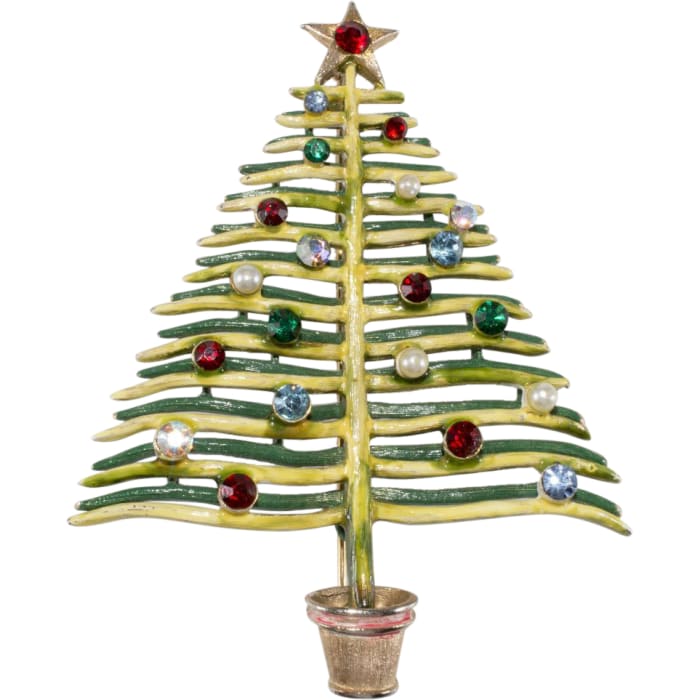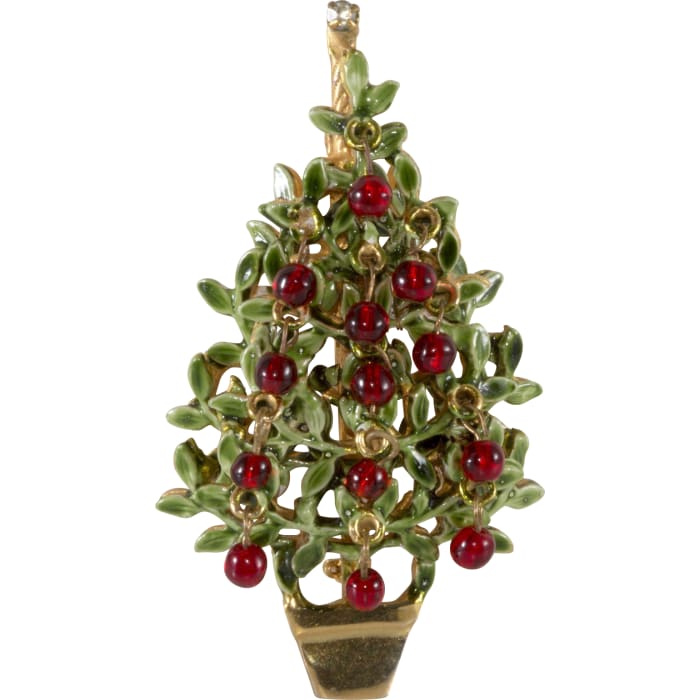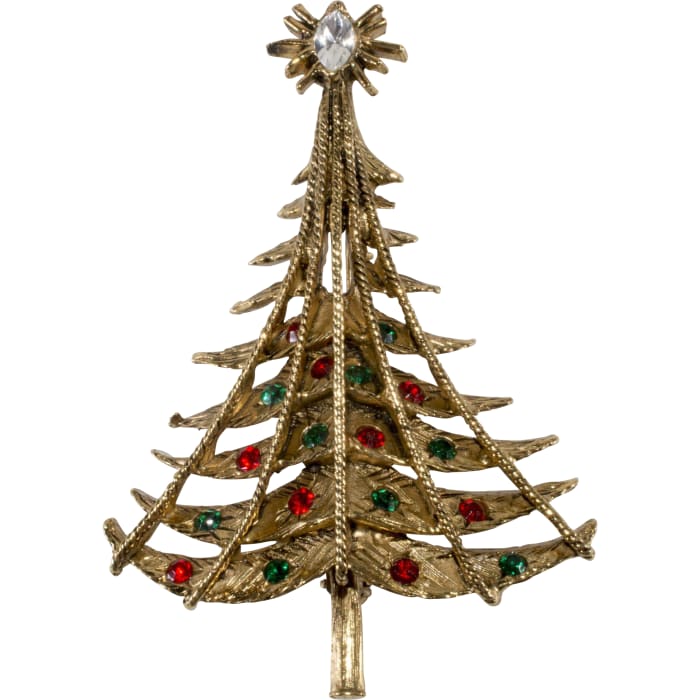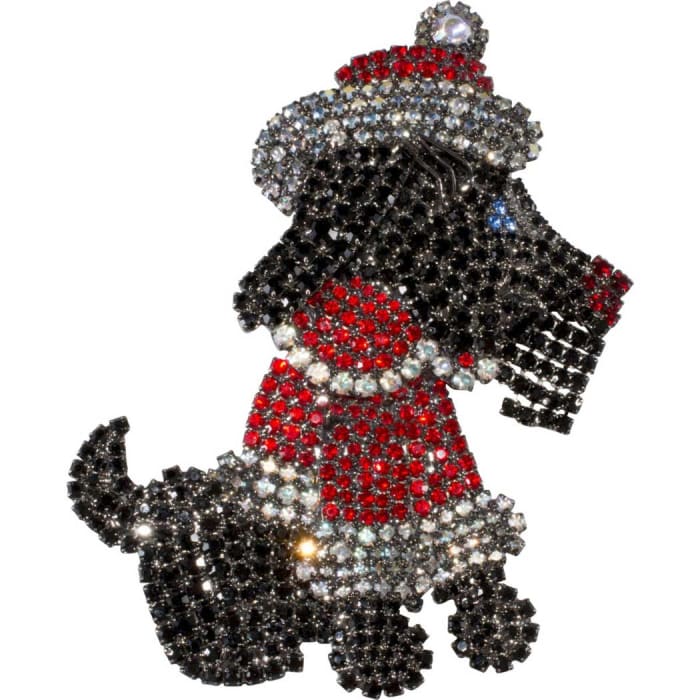While it might only come to the front of the wearable line between Thanksgiving and Christmas, hunting holiday-themed jewelry all year long is a pastime for many collectors. I count myself among them with a penchant for Santa Claus brooches, but I also have a few Christmas tree pins and other assorted goodies in my holiday stash. I always look forward to wearing a different piece each day to celebrate the season but it’s actually a tradition that’s been alive for decades.
Jewelry worn during the Christmas season started gaining popularity in the 1940s and ‘50s. Most of the pieces made early on were novelty items like plastic Merry Christmas pins sold in dime stores. The ‘50s got a bit more elaborate with ornament-laden corsage-type pins worn on coats, ceramic Santa face jewelry, and the advent of the plastic Santa with a light-up nose coveted by kids everywhere. That particular craze lasted into the 1960s.
Many traditional costume jewelry companies started making holiday jewelry during the 1960s as well, with Christmas tree pins being a big seller. The trend continued into the early 1970s.
New collectors discovering vintage jewelry created a renewed interest and revival in the late 1990s and early 2000s. A number of contemporary jewelry artisans started producing Christmas pieces during this period including Lawrence Vrba, Bettina von Walhof, Dorothy Bauer and Dominic DeToro who crafted jewelry marked Dominique. These pieces, some of which are very large and elaborate, quickly became collectibles.
Some companies made limited edition Christmas jewelry as well during the early- to mid-2000s. This is true for Swarovski with their line of Rockefeller Center tree pins. Lunch at the Ritz produced some really clever designs with multi-layer dangling elements in a variety of styles as did Kirk’s Folly. Avon even got in on the fun with mass-produced Christmas tree pins during this period.
The main focus 15-20 years ago, however, was on garnering vintage pins for collections and that aspect of the hobby is still thriving today. Once you start avidly shopping for vintage holiday jewelry, especially Christmas tree pins, you’ll likely notice a few names cropping up over and over again.
Mylu, Hollycraft, Art, and J.J.
One of the brands Christmas jewelry collectors run across frequently is Mylu. While not overly expensive, Mylu trees are nicely made and usually fairly traditional in their styling. The company was started by sisters Lynne Gordon and Marge Borofsky sometime after 1955 and became a part of Coro in 1968. The sisters oversaw production of the Mylu division of Coro until they left in 1970 to partner with Michael Tancer to form a new business called Tancer & Two (marked Tancer II). Some Mylu designs carried over to the new company, but Tancer & Two made some unique tree designs as well including one decorated with genuine fur.
Hollycraft is another business that made a number of different holiday designs. While the company’s Christmas tree pins are found more frequently, they made several different Santa pins and other holiday styles trimmed with holly and garland. This business was founded by Joseph Chorbajian in the 1930s as Hollywood Jewelry Mfg. Co. They made jewelry marked Hollycraft, but also produced jewelry for other companies including Pakula. That’s why some Pakula marked holiday pins look very similar to Hollycraft pieces. Most of their Christmas jewelry was manufactured during the 1960s. Collectors tend to run across the best-selling Hollycraft Christmas pieces frequently but should keep an eye out for rarities that can be worth far more than average. Some of the original art renderings for rare designs can be viewed on the Costume Jewelry Collectors International website.
Another company that made quite a few Christmas styles is Mode-Art. The jewelry, however, is actually marked ART in most instances. Founded by Arthur Pepper around 1950, most of the Christmas jewelry made by this company also has a copyright symbol indicating manufacture after 1955. In addition to tree pins, they made wreaths, angels, and candles, along with other holiday-themed designs. Most have a smattering of colorful rhinestones and some have enameled accents. The quality is a rung down from Mylu and Hollycraft, but ART holiday pieces are still affordable and highly wearable collectibles.
Even more affordable are the pins marked J.J. representing Jonette Jewelry Company. The J.J. mark was first used in 1970 after the company name changed from Lisker & Lisker. The business made a wide variety of novelty jewelry including humorous Christmas styles that include animals like cats and mice dressed as Santa Claus. They also made a number of tree pins which are plentiful in the vintage marketplace today. There are many other budget-wise pieces by names like Hedy and Gerry’s along with unmarked examples to discover.
On the other side of the affordability scale you have big name manufacturers like Trifari who made a limited number of Christmas designs. From popular Weiss trees with “candles” to Carnegie’s light-up tree, Eisenberg’s glass tree, and Robert designs with dangling beads, these are harder to find and largely sought by more advanced keepers of Christmas spirit.
Learn More About Christmas Jewelry
Several books have been written on the topic of collecting holiday jewelry and a couple are still in print. Of those, I recommend Christmas Tree Pins: O Christmas Tree by Nancy Yunker Trowbridge. Another title worth looking up is Christmas Pins Past & Present, Third Edition by Jill C. Gallina. This reference guide is especially pertinent if you’d like to learn more about more contemporary designer Christmas jewelry along with designs beyond trees.
You May Also Like:
How to Identify Unmarked Jewelry













